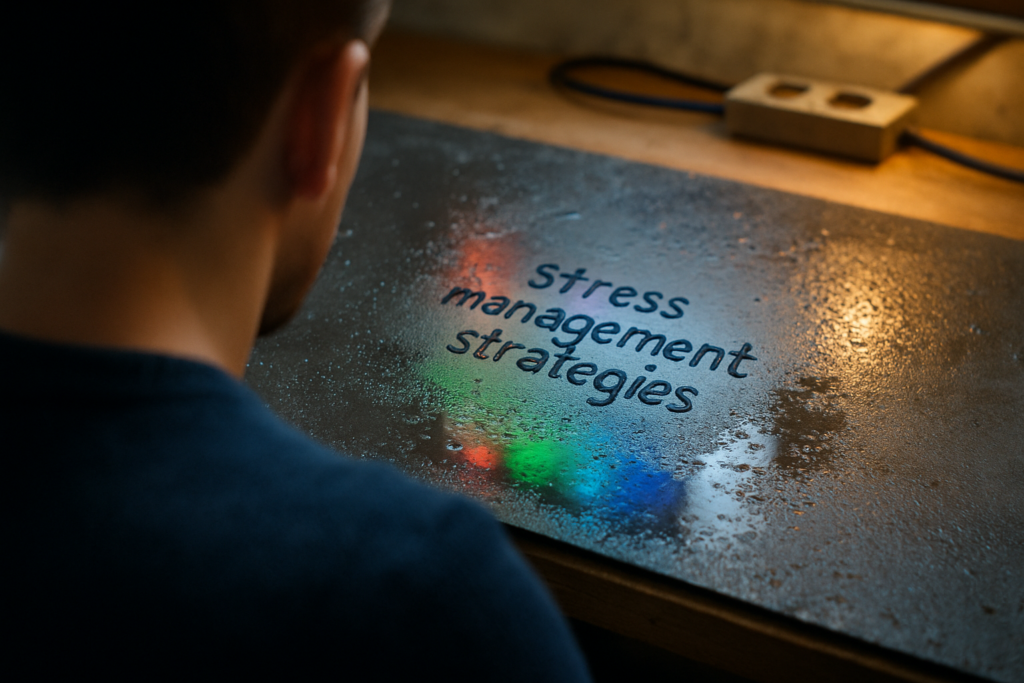Understanding Everyday Stress
Stress doesn’t show up out of nowhere. It creeps in through traffic, deadlines, group chats, news alerts, multitasking, and feeling like you need to be “on” 24/7. Most of us are juggling way more than we admit and our nervous systems are paying the price.
Daily tension often stems from chronic overwhelm. Long work hours, digital noise, lack of sleep, and minimal downtime pile up fast. Even minor things cluttered spaces, constant notifications, poor boundaries can quietly push your stress baseline higher.
The signs aren’t always obvious. Some days it looks like tension in your jaw or neck. Other times it’s irritability, fatigue, or brain fog that won’t lift. You might notice racing thoughts or that everything feels urgent, even when it’s not. These are cues your body’s stuck in stress mode.
Managing stress daily isn’t fluff it’s maintenance. Just like brushing your teeth, it’s better to do a little every day than wait for a crisis. Daily stress relief keeps things from boiling over and helps you respond to real pressure with a clearer head and steadier footing.
Breathing Hacks That Work
When anxiety hits or focus slips, your breath is the fastest tool you’ve got. No apps, no gear just lungs.
Start with 4 7 8 breathing. Inhale for four seconds, hold for seven, exhale for eight. Three rounds can lower your heart rate, quiet your thoughts, and shift your nervous system out of fight or flight. It’s a reset button disguised as breathing.
Box breathing is another heavy hitter. It’s used by athletes, performers, even Navy SEALs for a reason. Inhale four seconds, hold four, exhale four, hold again for four. This rhythm calms the chaos and locks in your attention. Perfect before a high pressure meeting, a big decision, or whenever the mental static is too loud.
Here’s why these methods work: slow, controlled breathing signals your parasympathetic nervous system, the part that tells your body it’s safe. Blood pressure drops. Muscles unclench. Your brain shifts gears from panic to presence. No magic, just biology. And the more often you do it, the faster your body learns to use these signals.
Simple movements of air. Small seconds spent. Big difference in how you move through your day.
Strategic Movement, Not Just Exercise
You don’t need a gym membership to feel better. A five minute walk around the block can clear out low level anxiety like nothing else. It’s not about getting a workout in. It’s about movement rhythmic, grounded, and simple. Your brain lights up, your breath evens out, and suddenly that thing you were spiraling about? It feels smaller.
Stretching is another low effort, high reward mental reset. Step away from the screen, touch your toes, roll out your shoulders. It’s not glamorous. But it’s effective. A tight body holds stress; a looser one helps it pass through.
And if you’ve got 10 or 15 minutes? Gentle yoga or tai chi works wonders. Slow, deliberate movement pulls your nervous system out of fight or flight and back into rest mode. Nothing extreme just enough to tell your brain, “We’re OK.” It’s less about flexibility and more about flow. Reset, then re enter your day with a steadier pulse.
Make Your Space Work for You

Stress thrives in chaos. That doesn’t mean your room has to look like a showroom, but visual clutter adds to mental clutter. If your desk is buried in to do lists, old mugs, and tangled cords, it’s not just annoying it’s overwhelming. Clearing off surfaces, even just the area you can see while you work or relax, strips away a layer of background noise.
Natural light also pulls its weight. It signals your body it’s daytime, helps you feel more awake, and can even boost mood. If you’re stuck in a darker spot, mirrors and light walls can cheat more brightness into your space. Same goes for quiet corners whether it’s a reading chair, a clear kitchen table, or the front seat of your parked car. Anywhere you can briefly reset counts.
Micro moments of stillness matter more than perfect calm. A deep breath while making coffee, five calm minutes before checking your phone, or just looking out the window undistracted. Your environment doesn’t need to be silent or sacred it just needs to give you some breathing room.
Mini Mindfulness Moments
When stress spirals, you need something that cuts through the noise fast. That’s where grounding techniques come in. Try the 5 4 3 2 1 method: name 5 things you can see, 4 you can touch, 3 you can hear, 2 you can smell, and 1 you can taste. It sounds simple because it is, but when your brain is racing, these anchors bring you back to the now.
Another go to is the body scan. Doesn’t take more than two minutes. Sit or lie still, breathe slowly, and bring your attention to one part of your body at a time feet to forehead. No fixing, just noticing. It interrupts overthinking and lets you reset without much effort.
Mindfulness doesn’t need to be a full ritual, and it doesn’t need an app. You can stack it onto habits you already have. Waiting for your coffee? Close your eyes and breathe deeply. Standing in line? Feel your weight balance between your feet. These little check ins are stealthy but strong they train your brain to pause before it overloads.
Build a Personal Stress Kit
Creating a go to set of comfort tools can help you manage stress before it escalates. Your personal stress kit should be simple, accessible, and meaningful something you can turn to when things feel overwhelming.
Go To Tools That Ground You
Consider adding a few of the following to your physical or mental toolkit:
Music: Create playlists that calm or energize depending on your needs
Scents: Use essential oils or candles lavender, eucalyptus, or citrus can shift your mood quickly
Tactile Objects: Small items that feel safe and familiar (smooth stones, textured fabrics, stress balls)
Comfort Rituals: A hot cup of tea, a warm shower, or revisiting a favorite book
These aren’t luxuries they’re mental reset buttons.
Recognize the Red Flags Early
Noticing that you’re nearing your stress limit is crucial. Learn to identify your early warning signs:
Sudden irritability or restlessness
Physical tension in your jaw, neck, or shoulders
Scattered thoughts and difficulty focusing
Trouble falling or staying asleep
Once you recognize these signs, take small, immediate steps to alleviate pressure like stepping outside, doing one deep breath cycle, or pausing your work for five minutes.
Create Boundaries That Protect Your Energy
Stress often builds in the spaces where boundaries are weakest. Think about where you can build safe buffers:
Tech timeouts: Schedule screen free blocks during your day
Transition habits: Create simple rituals between work and rest (e.g., changing clothes, stepping outside)
No guilt pauses: Allow short breaks without justifying them pause because you need to, not because you’ve earned it
These small structural changes can help prevent burnout and keep your nervous system from being on constant alert.
Find What Works for You
There’s no universal fix for stress. What grounds one person might frustrate another. The key is rhythm finding a pace and pattern that works with your day to day, not against it. Maybe that’s five minutes of breathwork before emails. Maybe it’s stepping outside every afternoon, no matter what.
Stress relief isn’t plug and play. It’s trial and error. Don’t feel bad for switching things up. If journaling feels forced, don’t do it. If morning walks don’t stick, try evenings. What matters is staying curious about what helps then building on what works.
Need ideas? Here’s a library of stress relief techniques that might click for you.
Sustain the Calm
Big stress relief wins don’t come from a once a month spa day. They come from small things you do every day. A two minute breathing break. A short walk before lunch. Logging off at a set time. When it comes to staying grounded, consistency beats intensity every time.
A calm day isn’t one that’s completely quiet or perfectly planned out. It might include back to back meetings, but still leaves space to sip your coffee without checking notifications. It’s not about being slow it’s about being present, moment to moment. That means giving yourself permission to reset, even in the middle of the rush.
The point isn’t to aim for some flawless routine. It’s to build a rhythm that keeps your nervous system from tipping into overdrive. That can be as simple as taking five full breaths before your next task or muting your inbox after 8 p.m.
Everyone’s version of ‘calm’ will look different. Want more tools to figure out yours? Check out these stress relief techniques for easy, effective ways to lower the volume on stress your way, your pace.


 Nicoleeny Castrolos, the founder of Body Care And Matter, is a passionate advocate for health and wellness. With a deep commitment to improving the lives of individuals, Nicoleeny has built a platform dedicated to delivering the latest insights on men’s and women’s health, nutrition, and mental wellness.
Nicoleeny Castrolos, the founder of Body Care And Matter, is a passionate advocate for health and wellness. With a deep commitment to improving the lives of individuals, Nicoleeny has built a platform dedicated to delivering the latest insights on men’s and women’s health, nutrition, and mental wellness.

